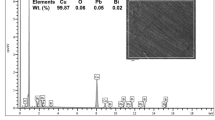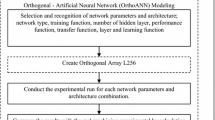Abstract
This paper presents a framework of data-driven intelligence system which can be applied on magnetic field-assisted electrical discharge machining (MF-EDM) machining process for SiC particulate reinforced Al-based metal matrix composites (SiCp/Al) with different high-volume fractions. The implemented system consists of data modelling, predicating, optimization and monitoring modules. A multi-objective moths search (MOMS) optimization algorithm with backpropagation neural network (BPNN) model and multi-hierarchy non-dominated strategy is proposed for tuning optimal processing performance. Data are collected from machining different fraction volumes of SiCp/Al composites by MF-EDM, with peak current, magnetic, pulse width and pulse interval time as input, and material removal rate, electrode wear rate, surface roughness as output. The BPNN model shows the best accuracy compared to K-nearest neighbors, least square support vector machine and Kriging model. To demonstrate the effectiveness of the MOMS optimization algorithm, a set of results is selected as paradigm, which dominates 95.83% original experiments. A verification experiment is also done for an optimized parameter with 65% fraction and 0.2T magnetic. Both result data and three-dimensional surface topography comparison show that the verification experiment result dominates the original experiment of similar input designs.










Similar content being viewed by others
References
Wang C, Wang Y, Wang K, Dong Y, Zhou X, Wang S (2017) Cutting parameters optimization based on itlbo algorithm with big data driven. In 2017 IEEE International Congress on Big Data (BigData Congress) pp. 577–581
Luo H, Li K, Kaynak O, Yin S, Huo M, Zhao H (2020) A robust data-driven fault detection approach for rolling mills with unknown roll eccentricity. IEEE Trans Control Syst Technol 28:2641–2648
Bellotti M, Wu M, Qian J, Reynaerts D (2020) Tool wear and material removal predictions in micro-edm drilling: Advantages of data-driven approaches. Appl Sci 10
Saha S, Gupta KK, Maity SR, Dey S (2021) Data-driven probabilistic performance of wire edm: A machine learning based approach. Proceedings of the Institution of Mechanical Engineers, Part B: J Eng Manuf
Kong X, Wang J, Wang M, Wang B, Zheng Y, Yang L (2021) Mechanisms involved in the tool life improvement of laser assisted machining 45% sicp/al composites. Opt Laser Technol 139
Xiong B, Xu Z, Yan Q, Lu B, Cai C (2011) Effects of sic volume fraction and aluminum particulate size on interfacial reactions in sic nanoparticulate reinforced aluminum matrix composites. J Alloy Compd 509:1187–1191
Maruyama B (1999) Discontinuously reinforced aluminum: Current status and future direction. Journal of the Minerals, Metals & Materials Society (JOM) 51:59–61
Du J, Ming W, Cao Y, He W, Li X (2019) Particle removal mechanism of high volume fraction sicp/al composites by single diamond grit tool. Journal of Wuhan University of Technology-Mater. Sci. Ed. 34:324–331
Gururaja S, Ramulu M, Pedersen W (2013) Machining of mmcs: A review. Mach Sci Technol 17:41–73
Pramanik A (2014) Developments in the non-traditional machining of particle reinforced metal matrix composites. Int J Mach Tool Manuf 86:44–61
Zhang Z, Zhang Y, Liu D, Zhang Y, Zhao J, Zhang G (2022b) Bubble behavior and its effect on surface integrity in laser induced plasma micro-machining silicon wafer. J Manuf Sci Eng 144(9):091008
Ming W, Jia H, Zhang H, Zhang Z, Liu K, Du J, Shen F, Zhang G (2020) A comprehensive review of electric discharge machining of advanced ceramics. Ceram Int 46:21813–21838
Garg R, Singh K, Anish S, Sharma V, Ojha K, Singh S (2010) Review of research work in sinking edm and wedm on metal matrix composite materials. Int J Adv Manuf Technol 50:611–624
Ho K, Newman S (2003) State of the art electrical discharge machining (edm). Int J Mach Tool Manuf 43:1287–1300
Seo YW, Kim D, Ramulu M (2007) Electrical discharge machining of functionally graded 15–35 vol sicp/al composites. Mater Manuf Processes 21:479–487
Yang W-S, Chen G-Q, Wu P, Hussain M, Song J-B, Dong R-H, Wu G-H (2017) Electrical discharge machining of al2024-65 vol sic composites. Acta Metallurgica Sinica (English Letters) 30:447–455
Zhang Z, Zhang Y, Lin L, Wu J, Yu H, Pan X, Li G, Wu J, Xue T (2021b) Study on productivity and aerosol emissions of magnetic field-assisted edm process of sicp/al composite with high volume fractions. J Clean Prod 292
Zhang Z, Zhang Y, Ming W, Zhang Y, Cao C, Zhang G (2021c) A review on magnetic field assisted electrical discharge machining. J Manuf Process 64:694–722
Li J, Laghari R (2019) A review on machining and optimization of particle-reinforced metal matrix composites. Int J Adv Manuf Technol 100
Maity K, Mishra H (2018) Ann modelling and elitist teaching learning approach for multi-objective optimization of \(\mu\)-edm. J Intell Manuf 29:1599–1616
Taguchi G, Elsayed E, Hsiang T (1988) Quality Engineering in Production Systems. McGraw-Hill College
Ong P, Chong CH, Bin Rahim, MZ, Lee WK, Sia CK, Bin Ahmad MAH (2020) Ann modelling and elitist teaching learning approach for multi-objective optimization of \(\mu\)-edm. J Intell Manuf 31:227–247
Jurkovic Z, Cukor G, Brezocnik M, Brajkovic T (2018) A comparison of machine learning methods for cutting parameters prediction in high speed turning process. J Intell Manuf 29:1683–1693
Maji K, Pratihar D (2011) Modeling of electrical discharge machining process using conventional regression analysis and genetic algorithms. J Mater Eng Perform 20:1121–1127
Ming W, Ma J, Zhang Z, Huang H, Shen D, Zhang G, Huang Y (2016) Soft computing models and intelligent optimization system in electro-discharge machining of sic/al composites. International Journal of Advanced Manufacturing TechnologySoft computing models and intelligent optimization system in electro-discharge machining of SiC/Al composites 87:201–217
Chakraborty S, Chakraborty R, Nagendrababu K, Talla G, Gangopadhyay S (2016) Multi-response optimisation of surface texturing using artificial bee colony algorithm. International Journal of Mechatronics and Manufacturing Systems 9:272–295
Mohanty C, Mahapatra S, Singh D (2014) A particle swarm approach for multi-objective optimization of electrical discharge machining process. J Intell Manuf 27:1–20
Wang G (2018) Moth search algorithm: a bio-inspired metaheuristic algorithm for global optimization problems. Memetic Computing 10:151–164
Friedman JH (1994)Flexible Metric Nearest Neighbor Classification. Tech Rep
Cortes C, Vapnik V (1995) Support-vector networks. Mach Learn 20:273–297
Suykens JAK, Gestel TV, Brabanter JD, Moor BD, Vandewalle J (2002) Least Squares Support Vector Machines. World Scientific
Krige DG (1951) A statistical approach to some basic mine valuation problems on the witwatersrand. J South Afr Inst Min Metall 52:119–139
Cheng J, Jiang P, Zhou Q, Jiexiang H, Yu T, Shu L, Shao X (2019) A lower confidence bounding approach based on the coefficient of variation for expensive global design optimization. Eng Comput 36:830–849
Rumelhart DE, Hinton GE, Williams RJ (1986) Learning representations by back-propagating errors. Nature 323:533–536
Hecht-Nielsen (1989) Theory of the backpropagation neural network. In International 1989 Joint Conference on Neural Networks (pp. 593–605 vol.1)
Zhang Y, Zhang G, Zhang Z, Zhang Y, Huang Y (2022a) Effect of assisted transverse magnetic field on distortion behavior of thin-walled components in wedm process. Chin J Aeronaut 35:291–307
Zhang Y, Zhang Z, Zhang Y, Liu D, Wu J, Huang Y, Zhang G (2021a) Study on machining characteristics of magnetically controlled laser induced plasma micro-machining single-crystal silicon. J Adv Res 30:39–51
Zhang Z, Liu D, Zhang Y, Xue T, Huang Y, Zhang G (2022c) Fabrication and droplet impact performance of superhydrophobic Ti6al4v surface by laser induced plasma micro-machining. Appl Surf Sci 605:154661
Acknowledgements
The authors would like to thank Mr. Haishen Yu and Mr. Liquan Lin for preparing the experiments.
Funding
This research is supported by National Key R&D Program of China (No. 2020YFB2008203), Project named “Mold design, manufacturing and high-efficiency precision molding of small module gear”.
Author information
Authors and Affiliations
Contributions
Tao Xue: conceptualization, methodology and writing; Long Chen: software and validation; Jiaquan Zhao: design and writing. Zhen Zhang: experiment and analysis; Yi Zhang: experiments; Dongxu Wen: funding and resources, Huachang Wang: funding and resources.
Corresponding authors
Ethics declarations
Ethics approval
There is no ethical approval needed in the present study.
Consent to participate
Not applicable
Consent for publication
All authors agree to publish.
Conflicts of interest
The authors declare no competing interests.
Rights and permissions
Springer Nature or its licensor holds exclusive rights to this article under a publishing agreement with the author(s) or other rightsholder(s); author self-archiving of the accepted manuscript version of this article is solely governed by the terms of such publishing agreement and applicable law.
About this article
Cite this article
Xue, T., Chen, L., Zhang, Z. et al. Data-driven analysis in magnetic field-assisted electrical discharge machining of high-volume SiCp/Al. Int J Adv Manuf Technol 122, 2775–2791 (2022). https://doi.org/10.1007/s00170-022-09940-4
Received:
Accepted:
Published:
Issue Date:
DOI: https://doi.org/10.1007/s00170-022-09940-4




